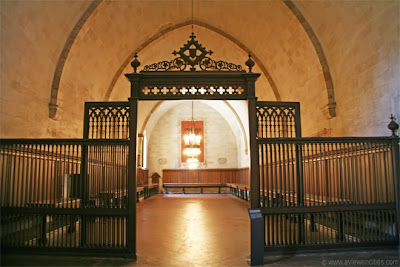The Monastery Refectory and Kitchen
Though the sisters had their day cells - in some cases elaborately decorated with murals, tapestries and frescoes - much of the life in the Monastery was of a communal nature. The second floor dormidor was a common sleeping room though it may have been subdivided by wooden or tapestry partitions to allow for some privacy. Traditionally the sub-prioress would sleep closest the entrance to monitor what was happening in the dormitory and to take attendance. The dormitory normally had - as it does at Pedralbes - easy access to the Nun's gallery of the adjacent church as attendance at offices was required as part of the rule of the order. |
| The Refectory of the Monastery is on the ground floor and accessible from the North end of the cloister through a carved wooden grill. |
 |
| The sisters sat along the wall and the tables were fixed to the stone floor - you have to wonder what purpose the rest of the wide open space served? The lector for the day would read from the pulpit high up on the left of the room. |
If the refectory is much as it was and has been for the past 600 years the adjacent kitchen showed the advancements in cooking equipment over several centuries. There is no sign of the open fireplaces that would have originally been used in the early years - possibly they were bricked up. But a wonderful collection of old cast iron stoves, modern gas burners and an even older ceramic stove gave hints of how meals were prepared. Even the tiles gave indication of the passage of time - large stark white tiling that suggested the 1930s, obviously factory made blue and white tiles of the late-19th early-20th century and most notably hand painted tiles from the 17th century. The later creating one of the most fanciful and charming back splashes I've ever seen for the marvelous ceramic stove.
 |
| As Gothic as the refectory may be the adjacent kitchen reflects modern (?) advancements in cooking equipment. I wonder if the hot water tank is still fed by the cistern in the cloister? |
 |
| This marvelous ceramic stove probably dates from the 16th-17th century. It was an efficient way of getting the maximum amount of heat from a minimum amount of fuel. |
But the colourful ceramic was more than a decorative element on this early masonry stove. It was an even and long lasting conductor of heat. Masonry stoves were fuel efficient - hay, twigs or split logs could be burned in them and burned at a high temperature. A small fire could give heat that would last up to six hours after the fire had died down. This meant that a single fire could handle much of the cooking needs for the day.
The decorative tiles on the back splash would have also retained and reflected heat as well as being a source of both religious contemplation and, possibly, amusement.

I recently found a great little free programme which creates mapping links on photos in a few easy steps. I've used it to allow close ups of the charming primitive tiles on the back guard of the Monastery stove. As you move your mouse over each tile a left click or use the links at the bottome of the picture to enlarge the tile in another window for a closer look. Thanks to image-maps.com for a very cool tool.
December 14 - 1287: St. Lucia's flood: The Zuiderzee sea wall in the Netherlands collapses, killing over 50,000 people.



No comments:
Post a Comment